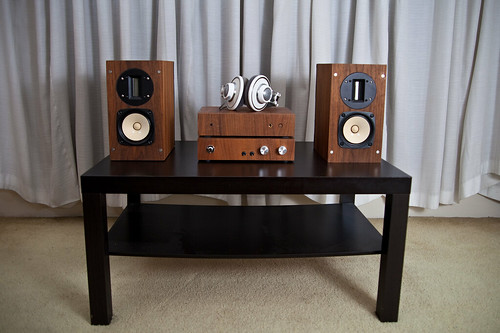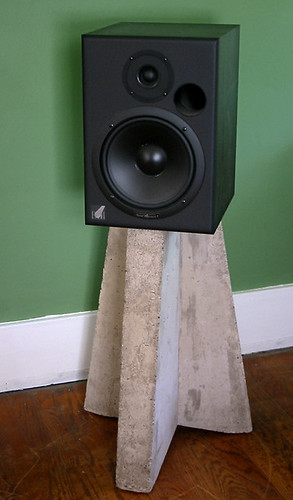Further to yesterday's post about speakers:

(Image source: Flickr user Enrico Salad)
If you're looking for some reading matter to ease you into loudspeaker design and construction, do not buy Vance Dickason's famous, though now out of print, Loudspeaker Design Cookbook. Even getting a pirated PDF of it is not a great idea. This is because the Design Cookbook is for people who already know what they're doing - its subtitle is "Everything you Need to Become a Better Speaker Designer", emphasis mine. You're going to have to learn about Thiele/Small parameters and some other technical stuff at some point if you're building most kinds of multi-driver and ported loudspeaker, but there are several kinds of speaker you can build without doing anything beyond basic arithmetic.
There are a ton of books about speaker design, most of which I've never read, so maybe I'm about to suggest you go in a non-optimal direction. But the best book I have read on the subject is V.A. Capel's An Introduction to Loudspeakers and Enclosure Design, which is also out of print but can still be had cheaply on Amazon
and on eBay (there are local Australian and UK sellers!UK sellers!).
An Introduction to Loudspeakers and Enclosure Design does what it says on the tin, and includes detailed instructions for building one of those single-cheap-driver transmission-line speakers I'm so keen on. If you build it according to the instructions you'll end up with a folded transmission line with ceramic-tile reflectors on the corners; I'm pretty sure just making the reflectors out of wood wouldn't significantly hurt performance.

(Image source: Flickr user Moisturizing Tranquilizers)
You don't have to do all the extra woodwork required to make a transmission-line enclosure, though. A simple sealed box with one driver will do.

(Image source: Flickr user Milestoned); these speakers are the Visaton Solo 100s, one of those short-form kits where you have to make your own boxes.
There's a whole subsection of the audiophile world - both the empirical and the woo-woo side - devoted to single-driver speakers, and such a speaker is a really good option for your first speaker project.

(Image source: Flickr user drosen7900)
A solidly constructed box with a single cheap driver can sound remarkably good, especially if the speakers are close to the listener, even though the response plot reports high treble and low bass are missing, presumed dead, and the midrange response looks like a Worms battlefield.
Loony-audiophile supply houses stand ready to relieve you of extraordinary amounts of money for Fostex or Tannoy drivers...

(Image source: Flickr user drosen7900. More about these speakers here.)
...but now that few people use CRT monitors and TVs, you can build your own computer or hi-fi/home-theatre speakers without even bothering to use magnetically shielded drivers. Any dirt-cheap paper-cone wideranges, or multi-driver round or oval car speakers (which are not strictly speaking single drivers, but can sound good just the same) will do.
And for your first project, all you need is a sealed box, the bigger the better, with one hole in the front that roughly fits a single driver. You will probably need to be able to solder, but not a lot of work is involved, and what work you do have to do can be quite sloppy and still give a perfectly functional result. (Think of it as the Roman Army knife of loudspeakers!)
Oh, and on the subject of very heavy speaker cabinets: What do you do if you've already got some speakers, but you want their cabinets to be less resonant?

(Image source: Flickr user Voxphoto)
Just cast your own speaker stands out of concrete, and bolt the speakers onto them!
25 August 2012 at 10:55 pm
Why not just cast your speakers out of concrete?
26 August 2012 at 9:46 am
As you say, it can be done, and has been done, in various ways.
If you can make it airtight, you can make a speaker out of it, and hope your floor can support it.
See also, granite slabs!
26 August 2012 at 11:14 am
Years ago your review of theloudspeakerkit’s M4 bookshelf speaker encouraged me to build half a dozen of them, which are still in use where the sound quality doesn’t matter.
Inspired to improve the sound, I read Rod Elliott’s explanation (at sound.westhost.com) of bi-amping, which led me to building a pair of Siegfried Linkwitz’s Plutos (linkwitzlab.com). These have their own power supply and amps; just plug in your MP3 player or preamp. Not cheap — if you build everything yourself there won’t be much change out of $1200, although this includes the four amplifiers — but the sound will beat any transmission line speaker that I’ve heard. Or indeed, any other speaker. And, because of their somewhat unusual appearance, no one will know that they are loudspeakers. Construction is easy since not much woodworking is needed, and if you are unsure about soldering you can buy the electronics assembled. I have little experience in electronics, but it all worked first time for me.
Worth a look.
27 August 2012 at 12:04 am
I, too, built a pair of LSK M4s after reading Dan's review. I went the bespoke option for my next set, though, with MTM floor-standers, with 2 x Peerless 5" drivers & a Peerless HDS tweeter. The sound, if I don't mind saying so, is frikkin' awesome!
They might only be 5" drivers, but they still put out quite a lot of bass, which is why my 12" sub has been gathering dust for the last couple of years. Not only is it not really needed (unless we're planning to annoy the neighbours!), but the extra bass would be less-than-useful when trying to watch a movie while the toddlers are asleep. :-(
Unfortunately, my budget doesn't stretch to building a room to hold my speakers...
(Interesting side-note: the higher dynamic range audio you get with Blu-Ray movies is not a plus when trying to watch movies without disturbing sleeping toddlers. You're constantly surfing the volume control between quieter-than-a-butterfly's-fart dialogue and they-damn-well-better-hear-this-in-the-next-town action scenes. A receiver/amp with audio compression would be nice, but that, too, is out of my budget...)
27 August 2012 at 7:26 am
Behringer has a limiter on some of their cheaper EQs
27 August 2012 at 6:44 pm
You could also experiment with compression in the player itself. If your Blu-Ray player doesn't have it (though it might have, lord knows what the manufacturer calls it though), you might try a cheapo chinese media box.
I use a EGREAT EG-R1, and it has normal, comfort and night mode audio settings. I presume that normal means no compression, while the other two are the progressively higher levels. And yes, they work over hdmi, the settings does not apply solely to the analog outputs.
Be warned though that this would mean you would have to rip the disc yourself to an external hard drive (or a simple usb disk). Legality and availability of ripping software probably varies by country. Also, the player does not support Blu-Ray menus (practically none of the cheap ones do), but will play the main feature without much fuss.